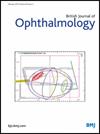Clinical characteristics and surgical outcomes of secondary full-thickness macular holes developing after vitrectomy
IF 3.5
2区 医学
Q1 OPHTHALMOLOGY
引用次数: 0
Abstract
Aim To describe the clinical features, anatomical and visual outcomes of secondary full-thickness macular holes (sFTMH) developing after pars plana vitrectomy (PPV). Methods The medical charts of patients from nine vitreoretinal services across the UK who, between 2009 and 2023, underwent PPV for different indications and subsequently developed sFTMH were retrospectively reviewed. Primary outcomes were clinical features, macular hole closure rate and change in best corrected visual acuity (BCVA). Patients with idiopathic FTMH (iFTMH) who underwent surgical repair in the same period acted as control data for optical coherence tomography (OCT) characteristics. Results Out of 16 939 PPV undertaken during the study period, 60 eyes of 60 patients (52% females, mean age 61.9 years) developed sFTMH, leading to an incidence of 0.4%. Median follow-up was 24.7 months. The median time from primary PPV to sFTMH diagnosis was 3 (range 0.4–81.4) months. OCT features of sFTMH were compared with 108 cases of iFTMH. Epiretinal membrane (ERM, 24.2%), epiretinal proliferation (ERP, 9.3%) and subretinal fluid cuff (53.7%) were more commonly observed in sFTMH compared with iFTMH (11.1%, p=0.03; 1.9%, p=0.03 and 33.3%, p=0.01, respectively). 10.9% of sFTMH developing after rhegmatogenous retinal detachment (RRD) were associated with giant-retinal tear (GRT) RRD. Single surgery success rate was 93.9%. In 3 (5%) eyes, sFTMH closed spontaneously. BCVA significantly improved from 1.0 logMAR to 0.7 logMAR at final visit. Conclusions sFTMH presented more commonly with ERM and ERP compared with iFTMH. A high incidence of GRT-related RRD was observed among the RRD cohort. Surgery achieves a closure rate of 93.9% and significant vision improvement. All data relevant to the study are included in the article or uploaded as supplementary information.玻璃体切除术后继发全层黄斑裂孔的临床特点及手术效果
目的探讨玻璃体部分切除术(PPV)后继发全层黄斑裂孔(sFTMH)的临床特征、解剖和视觉效果。方法回顾性分析2009年至2023年英国9家玻璃体视网膜服务机构因不同适应症接受PPV治疗并随后发展为sFTMH的患者的病历。主要结果为临床特征、黄斑孔闭合率和最佳矫正视力(BCVA)变化。在同一时期接受手术修复的特发性FTMH (iFTMH)患者作为光学相干断层扫描(OCT)特征的对照数据。结果在研究期间进行的16939例PPV中,60例患者(女性52%,平均年龄61.9岁)60只眼发生sFTMH,发生率为0.4%。中位随访时间为24.7个月。从原发性PPV到sFTMH诊断的中位时间为3个月(范围0.4-81.4)。将sFTMH与108例iFTMH的OCT特征进行比较。sFTMH患者视网膜上膜(ERM, 24.2%)、视网膜上增生(ERP, 9.3%)和视网膜下液带(53.7%)较iFTMH患者更为常见(分别为11.1%,p=0.03; 1.9%, p=0.03和33.3%,p=0.01)。在孔源性视网膜脱离(RRD)后发生的sFTMH中,10.9%与巨大视网膜撕裂(GRT) RRD相关。单次手术成功率93.9%。3只(5%)眼自发性闭眼。BCVA在最后一次访问时从1.0 logMAR显著改善到0.7 logMAR。结论与iFTMH相比,sFTMH在ERM和ERP中更常见。在RRD队列中观察到grt相关RRD的高发生率。手术愈合率达93.9%,视力明显改善。所有与研究相关的数据都包含在文章中或作为补充信息上传。
本文章由计算机程序翻译,如有差异,请以英文原文为准。
求助全文
约1分钟内获得全文
求助全文
来源期刊
CiteScore
10.30
自引率
2.40%
发文量
213
审稿时长
3-6 weeks
期刊介绍:
The British Journal of Ophthalmology (BJO) is an international peer-reviewed journal for ophthalmologists and visual science specialists. BJO publishes clinical investigations, clinical observations, and clinically relevant laboratory investigations related to ophthalmology. It also provides major reviews and also publishes manuscripts covering regional issues in a global context.

 求助内容:
求助内容: 应助结果提醒方式:
应助结果提醒方式:


